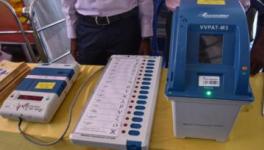Menstruation Taboo Claims Life of 14-year-old Girl in Tamil Nadu during Cyclone Gaja

Image Courtesy: The News Minute
The death of a 14-year-old Tamil Nadu girl, who was forced to sleep outside the home during cyclone Gaja since she was on her period, is the latest in the row of menstruation tribulation in our society. The social and religious stigma around menstruation has been prevailing in Indian society for long.
On November 16, at the time when the state was hit by Cyclone Gaja, S. Vijaya, a seventh standard student, who hails from Thanjavur district of Tamil Nadu, was staying separately in a hut outside her house since she was bleeding. She lost her life shortly after an uprooted coconut tree fell on the hut.
Staying alone in an isolated hut outside the house is a customary practice for girls who attain puberty in Tamil Nadu. This is exactly what forced Vijaya to stay outside the home during the deadly cyclone. In fact, as per the “customs”, she was supposed to stay in isolation for a long 16 days.
“It is a common practice for women in the villages to move into a different room and to be isolated when they are menstruating. But this is not talked about freely,” Kavya Menon, head of Project Safe Active Periods, AWARE (Awareness for Women to Advocate their Rights through Equality) India, was quoted as saying by The News Minute.
‘Menstrual Exclusion- A Form of Untouchability’
Even though the number of menstruating women in India is 355 million , accounting nearly 30 percent of the country’s total population, discrimination on the basis of menstruation which is a natural, biological and physiological process of a woman, still prevails. Recently on the grounds of Sabarimala Temple row, the Supreme Court had pronounced that menstruation could not be a ground to create any kind of social and religious barrier to women to enjoy the rights to equality and dignity given under the Indian Constitution.
“The stigma around menstruation has been built up around traditional beliefs in the impurity of menstruating women. They have no place in a constitutional order. These beliefs have been used to shackle women, to deny them equal entitlements and subjects them to the dictates of a patriarchal order. The menstrual status of a woman cannot be a valid constitutional basis to deny her the dignity of being and autonomy of personhood...,” Justice DY Chandrachud had said in his judgement.
“Prejudice against women based on notions of impurity and pollution associated with menstruation is a symbol of exclusion. The social exclusion of women, based on menstrual status, is but a form of untouchability which is an anathema to constitutional values,” Justice Chandrachud had added in his judgement.
Menstrual Discrimination and its Varied forms
The practice varies from place to place: in some places, isolation is practised only at the time of the first menstrual period. While, in some places, women have to stay in isolation every month. As part of the practice, bleeding women have to eat in separate plates, they are not allowed to use common bathrooms and water bodies. They are not even allowed to touch plants.
Since the menstruating woman is not allowed to enter the kitchen and cook food, they survive in the hut on the mercy of other family members who bring them food. The isolation points- huts- do not even have proper bedding.
In some regions, the isolated huts are located outside the villages. Poornima Javardhan, a 25-year-old woman from Sitatola village in Maharashtra explained how pathetic their conditions are. “During the rainy season, it is all the more difficult to stay in a gaokor because water comes inside and sometimes the roof leaks,” she said. Gaokor is the hut outside the village where the girls and women are being made to stay during their menstruation. As their thatched hut is often located on the edge of the forest, it is also common that wild animals attack the hut.
The girls even miss school as they are forced to be inside the huts during menstruation. A 2014 report by an NGO Dasra titled ‘Spot On’ had found that annually nearly 23 million girls drop out of schools due to lack of proper menstrual hygiene facilities. The report further found that 70% per cent of mothers with menstruating daughters considered menstruation as dirty and 71% adolescent girls remained unaware of menstruation till menarche.
A report from UNICEF in 2014, however, pointed out that 79% of women and girls in Tamil Nadu were unaware about menstrual hygiene practices. The report further stated that 66% per cent women in Uttar Pradesh, 56% in Rajasthan and 51% in West Bengal were also unaware about the same.
Get the latest reports & analysis with people's perspective on Protests, movements & deep analytical videos, discussions of the current affairs in your Telegram app. Subscribe to NewsClick's Telegram channel & get Real-Time updates on stories, as they get published on our website.
























